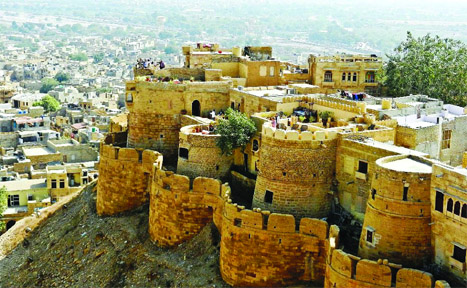
Jaisalmer is a prominent tourist spot located in the northwestern state of Rajasthan in India. It is known as the ‘golden city’ due to its golden dunes and castles clad in golden honey sandstone. Jaisalmer is adorned with lakes, ornate Jain temples and havelis. Climb onto the camel saddle and make your way through this desert to camp under the starry night sky for an unforgettable experience.
The Jaisalmer Fort stands as a citadel with narrow alleys inhabited by people for generations and shops selling colourful handicrafts.
Jaisalmer is a town, and to reach the Sand Dunes, travellers have to take a jeep safari followed by a camel ride. Thus, Jaisalmer is an amalgamation of exotic Indian desert culture, heritage and adventure.
JAISALMER FORT
Perched on top of a small hill, this large fort makes for a mesmerising sight. Also known as the Golden Fort, it is surrounded by a 30 foot high wall, and has over 99 bastions and some imposing gateways or pols. It has been inhabited for centuries, and encloses houses, handicraft shops, palaces, temples, hotels and restaurants, connected by cobble stone paths.
The main square here is called the Dussehra Chowk, while the main palace is the Rajmahal. This seven-storey building was the residence of the former rulers. Its façade is embellished with stone carvings, while its interior houses the Jaisalmer Fort Palace Museum and Heritage Centre. The rooftop offers panoramic views of the city.
JAIN TEMPLES
This set of seven Jain temples lies inside the walls of the Jaisalmer Fort. They are connected to each other, and are all adorned with intricate carvings of mythological and dancing figures. These yellow sandstone temples were built between the 12th and the 16th centuries. They are dedicated to various tirthankaras. The largest of them, the Parsvanath Temple, is dedicated to the 22nd tirthankara.
PATWON-KI-HAVELI
This ornate haveli is among the most splendid in Jaisalmer. It consists of a set of five houses, which were built by five Jain merchant brothers in the 19th century. Their exterior is covered with intricate carvings. Inside, some of the walls are decorated with paintings and mirror work. The buildings comprise of a set of rooms, constructed around a central courtyard. There’s also a shop selling embroidered textiles and brocades.
SAM SAND DUNES
These shifting white sand dunes, located close to the village Sam, are a great way to explore the Thar desert. They are located 45 kilometres from Jaisalmer. The best way to explore the desert is through camel rides. The dunes look especially picturesque at sunset and sunrise.
You can also stay here overnight to enjoy the campfires and folk music and dance performances held every evening. Rajasthan Tourism Development Corporation runs the Sam Dhani Resort on a hillock in front of the dunes. It has cottages and tents, which are perfect for a peaceful retreat.
SALIM SINGH-KI-HAVELI
This haveli was built by Salim Singh, the prime minister of Jaisalmer in the 19th century. Its most eye-catching feature is its beautiful arched roof with carved brackets shaped like peacocks, and pretty balconies below it. The haveli is also distinct because it’s been constructed entirely of stone, without the use of cement or mortar. A part of the haveli is still occupied, but it’s worth a visit primarily for its exquisitely designed exterior.
BADA BAGH
This garden, located on the outskirts of Jaisalmer, contains the cenotaphs of the Rajpur rulers. These are pyramidal and domed in shape, and have beautiful carved ceilings and equestrian statues of the rulers. Each chhatri also has inscribed tablets recording the death of the Maharawals. There’s also a set of windmills nearby, which make for a picturesque sight. There are several other attractions close to Bada Bagh. Amar Sagar consists of a beautifully-carved Jain temple located on the banks of a water reservoir. Lodhurva, the former capital of the Bhatti Rajputs, is now in ruins but it still has magnificent Jain temples with a gorgeous gateway. The main temple contains several beautiful sculptures and a silver image of Parsvanath, the 23rd tirthanakara.
GADSISAR LAKE
The beautiful rainwater lake is surrounded by numerous temples and pavillions, and offers magnificent views of Jaisalmer Fort. It was built by Maharawal Gadsi in the 14th century, and used to be the major source of drinking water for the city of Jaisalmer. It attracts water birds in winter and is a popular spot for bird watching, picnics and boating. There’s a lovely gateway called Tillon ki prol near the lake, built by a royal courtesan named Tillon.
NATHMAL-JI-KI-HAVELI
This 19th century haveli was built by two architect brothers, who designed their sections independently but with remarkable harmony. It has a beautifully carved exterior, while the interior is decorated with miniature paintings. Two yellow sandstone elephant figures guard the entrance to the haveli. There is no entry fee, but the family living here sells paintings and knick-knacks to tourists.





Be the first to comment